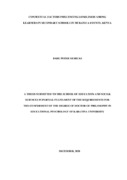| dc.description.abstract | The impact of loneliness on productivity among human beings and especially learners in secondary schools continue to be a subject of great concern to philosophers, educationists and policy makers. The contextual factors that influence loneliness among learners in secondary schools in Kenya and particularly in Murang’a County are not clearly known and documented. The purpose of this study was to assess the contextual factors that influence loneliness among learners in secondary schools in Murang’a County in Kenya. The objectives of the study were to; examine prevalence of loneliness among learners in secondary schools in Murang’a County, compare the correlates of loneliness among learners and evaluate the effectiveness of counselling in managing loneliness among learners in secondary schools in Murang’a County in Kenya. The study tested the following null hypothesis; HO1: there is no statistically significant difference in correlates of loneliness among learners in secondary schools in Murang’a County. The study was guided by Vygotsky’s Social Cognitive Learning Theory. The study adopted the cross-sectional survey research design. The target population was 100,684 learners found in the 303 public secondary schools in the County. Krejecie and Morgan Table was used to determine the sample size and stratified random sampling was used to select between 10% and 30% of the schools to participate in the study. All form two learners in the selected schools were purposively sampled to participate in the study. A questionnaire was used to collect demographic data. Scales to measure teacher-learner relationships and sense of belonging to school were adapted by the researcher for the study while PAL scale was used to measure level of loneliness. The scales and the questionnaire were piloted in similar type of schools in Kiambu County. Cronbach’s alpha Correlation Coefficient test of reliability of the questionnaire and scales yielded 0.83 which was acceptable. Descriptive and inferential statistics analysis was done using SPSS version 20. The study found that 39% to 55% of learners had had serious episodes of loneliness. Correlates of loneliness were found to vary by gender, school type and perception on effectiveness of guidance and counselling services. The study concluded that coeducation boarding schools presented unique challenges in management of loneliness. The study recommends strengthening of guidance and counselling services which should be tailored to specific school environment for effective management of loneliness. | en_US |
